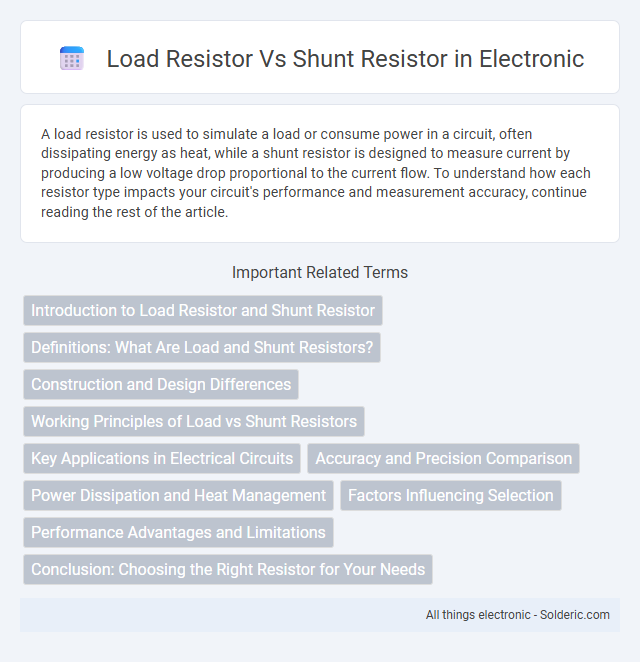A load resistor is used to simulate a load or consume power in a circuit, often dissipating energy as heat, while a shunt resistor is designed to measure current by producing a low voltage drop proportional to the current flow. To understand how each resistor type impacts your circuit's performance and measurement accuracy, continue reading the rest of the article.
Comparison Table
| Feature | Load Resistor | Shunt Resistor |
|---|---|---|
| Purpose | Limits current or dissipates power in a circuit | Measures current by producing a small voltage drop |
| Resistance Value | Typically higher resistance (ohms to kilo-ohms) | Very low resistance (milliohms to ohms) |
| Power Dissipation | Higher power dissipation compared to shunt resistor | Designed for low power loss |
| Common Applications | Load testing, voltage dropping | Current sensing in power electronics, battery management |
| Measurement Method | Indirect, by voltage drop across load | Direct, precise current measurement using voltage drop |
| Accuracy | Less precise for current measurement | High precision for current sensing |
| Typical Materials | Carbon film, metal oxide | Metal alloy (e.g., manganin, nichrome) |
Introduction to Load Resistor and Shunt Resistor
Load resistors and shunt resistors serve distinct roles in electrical circuits, with load resistors designed to consume power and provide a specific load to maintain circuit stability, whereas shunt resistors are primarily used for current measurement by creating a low-resistance path to divert current. Load resistors are commonly found in applications requiring voltage control and power dissipation, while shunt resistors are integral to precise current sensing in devices like ammeters and battery management systems. Both resistor types are selected based on resistance value, power rating, and accuracy requirements to optimize circuit performance.
Definitions: What Are Load and Shunt Resistors?
Load resistors are electrical components designed to simulate a real load by dissipating power in circuits, ensuring proper current flow and voltage regulation in applications like testing and simulation. Shunt resistors are precision resistors placed in parallel with a load to measure current by creating a small voltage drop proportional to the current passing through, enabling accurate current sensing in power management and monitoring systems. Both resistors serve distinct purposes, with load resistors used for power dissipation and shunt resistors for precise current measurement.
Construction and Design Differences
Load resistors are typically designed as high-power components with robust wire-wound or metal oxide film construction to dissipate significant heat during operation. Shunt resistors feature a low-resistance, precision design, often using metal foil or metal strip elements to provide accurate current measurement with minimal voltage drop. Your choice depends on whether you need a resistor for general load handling or precise current sensing applications.
Working Principles of Load vs Shunt Resistors
Load resistors operate by converting electrical energy into heat to simulate a real load in circuits, maintaining a fixed resistance to control current flow reliably. Shunt resistors function by providing a low-resistance path for current to pass through, enabling precise voltage drop measurement for accurate current sensing in electrical systems. The fundamental difference lies in the load resistor's role in power dissipation versus the shunt resistor's use primarily for measurement purposes.
Key Applications in Electrical Circuits
Load resistors are essential in electrical circuits for controlling current flow and dividing voltage, commonly used in LED lighting, power supplies, and sensor circuits to simulate real load conditions. Shunt resistors serve as precise current-sensing components in applications like battery management systems, motor control, and energy metering by providing accurate voltage drops proportional to current. Understanding the roles of these resistors can enhance Your circuit design by ensuring proper load regulation and current measurement.
Accuracy and Precision Comparison
Load resistors provide stable voltage drops for power applications but generally exhibit lower accuracy and precision in current measurement compared to shunt resistors. Shunt resistors are specifically designed to have very low and precise resistance values, enabling highly accurate current sensing with minimal power loss. For your measurement needs, selecting a shunt resistor ensures better accuracy and precision in current monitoring over load resistors.
Power Dissipation and Heat Management
Load resistors and shunt resistors differ significantly in power dissipation and heat management. Load resistors typically handle higher power levels by converting electrical energy into heat, requiring efficient heat sinks or cooling systems to prevent overheating. Your choice between these resistors impacts thermal design, as shunt resistors usually dissipate less power but demand precise thermal management to maintain accuracy and prevent drift.
Factors Influencing Selection
Load resistor and shunt resistor selection depends on factors such as power rating, tolerance, and resistance value to meet specific circuit requirements. Consider the measurement method, where shunt resistors are used for current sensing with low resistance to minimize voltage drop, while load resistors handle power dissipation in circuits. Your choice should also account for thermal management, accuracy, and the electrical characteristics of the application to ensure optimal performance.
Performance Advantages and Limitations
Load resistors offer stable power dissipation and simple integration in circuits but may generate excess heat and reduce efficiency in high-current applications. Shunt resistors provide precise current measurement with minimal voltage drop and improved accuracy but can be limited by their power rating and require careful placement to avoid signal interference. Choosing between them depends on your specific needs for accuracy, power handling, and thermal management.
Conclusion: Choosing the Right Resistor for Your Needs
Load resistors and shunt resistors serve distinct purposes in electrical circuits, with load resistors primarily managing voltage and current drop while shunt resistors facilitate precise current measurement by producing a small voltage proportional to the current. Selecting the right resistor depends on the application requirements, such as power rating, accuracy, and thermal stability, where load resistors suit power dissipation and circuit stabilization tasks, and shunt resistors are optimal for current sensing in measurement and control systems. Prioritizing factors like resistance value, tolerance, and environmental conditions ensures effective performance and longevity for the chosen resistor type.
Load resistor vs shunt resistor Infographic

 solderic.com
solderic.com